FRIDAY, JUNE 26
■ The Moon, almost first quarter, shines in the dim hind feet of Leo this evening (for North America). About 8° above the Moon you'll find brighter, 2nd-magnitude Denebola, Leo's tail tip.
Denebola forms an almost perfectly equilateral triangle with brighter Spica off to its left and Arcturus, brighter still, above them. All three sides of the triangle are close to 35° long (35.3°, 35.1°, and 32.8°). This has been called the Spring Triangle, a name that certainly fits. Can we make it stick?
■ Every morning now, Venus is getting a little higher and easier to spot in the east-northeast as dawn brightens, as shown below.
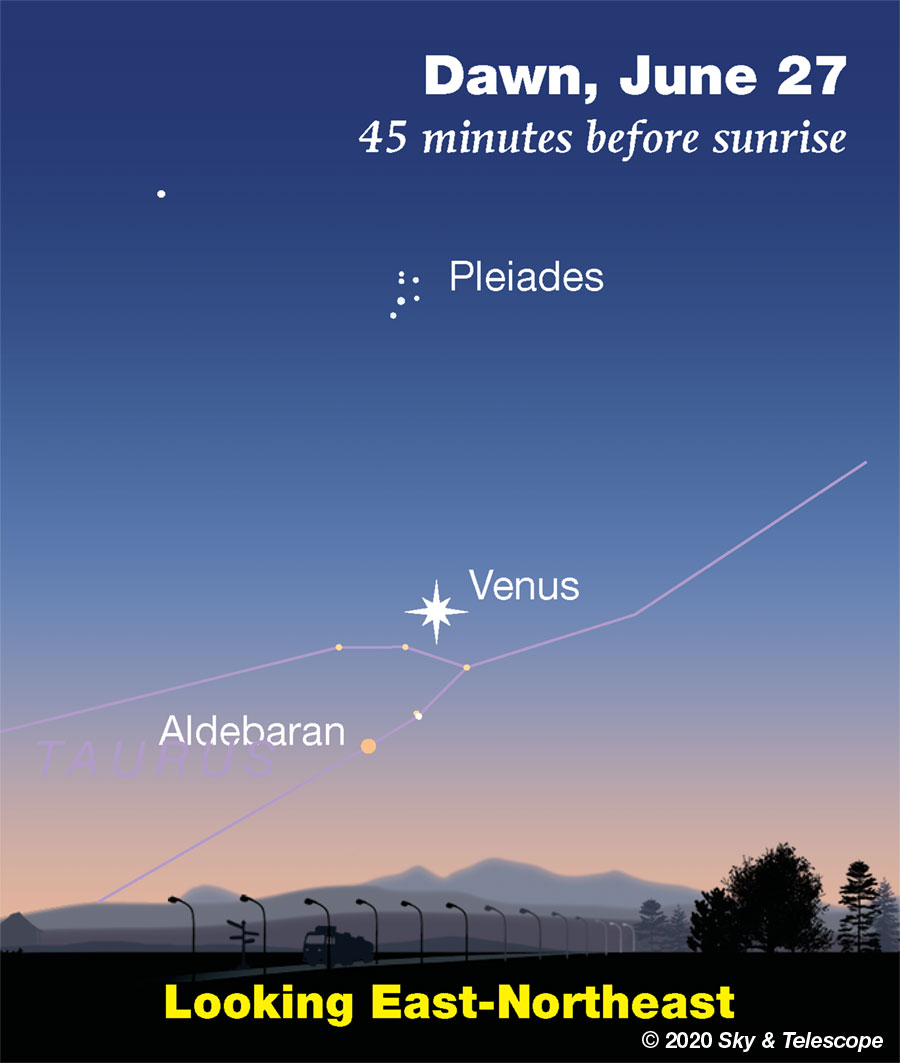
SATURDAY, JUNE 27
■ First-quarter Moon this evening and tomorrow evening. (The Moon is exactly first quarter at 4:16 a.m. Sunday morning EDT.) This evening, the Moon lies nearly along the line from Denebola (to the right of it) to brighter Spica (off to the Moon's left).
■ Low in the northwestern or northern sky at the end of these long summer twilights, would you recognize noctilucent clouds if you saw them? They're the most astronomical of all cloud types, and they're fairly rare — though growing more common in recent decades as the atmosphere changes. See Bob King's Nights of Noctilucent Clouds.
SUNDAY, JUNE 28
■ The first-quarter Moon forms a flat triangle with Spica to its lower left and 3rd-magnitude Gamma Virginis to its lower right. Gamma Vir (Porrima) is a close, equal double star for telescopes: separation 3.0 arcseconds this year, orientation north-south.
MONDAY, JUNE 29
■ As night falls, look for the Big Dipper hanging down in the northwest by its handle. Its bottom two stars, the Pointers, point to the right toward modest Polaris, the Little Dipper's handle-end. Most of the Little Dipper is very dim. This is the time of year when, at the end of twilight, it floats straight upward from Polaris — like a helium balloon escaped from some backyard.
The Little Dipper's one other moderately bright star, matching 2nd-magnitude Polaris, is Kochab on the lip of the Little Dipper's bowl. Look for it about a fist and a half above Polaris.
TUESDAY, JUNE 30
■ Now the Moon shines within a few degrees of Alpha Librae, a very wide double star with a separation of 231 arcseconds. The components are quite unequal, magnitudes 2.8 and 5.1.
■ The central stars of the constellation Lyra, forming a small triangle and parallelogram, dangle to the lower right from bright Vega high in the east. The two brightest stars of the pattern, after Vega, are the two forming the bottom of the parallelogram: Beta and Gamma Lyrae, Sheliak and Sulafat. They're currently lined up vertically. Beta is the one on top.
Beta Lyrae is an eclipsing binary star. Compare it to Gamma whenever you look up at Lyra. Normally Beta is only a trace dimmer than Gamma. Sooner or later, you'll probably catch Beta when it is very definitely fainter than usual.
WEDNESDAY, JULY 1
■ Now the waxing gibbous Moon shines within a couple degrees of Beta Scorpii, the top star of the three forming the Scorpion's head. Beta Sco is another famous telescopic double star: separation 14 arcseconds, magnitudes 2.8 and 4.9.
■ This is the time of year when the two brightest stars of summer, Arcturus and Vega, are equally high overhead shortly after dark. Arcturus is toward the southwest, Vega is toward the east.
Arcturus and Vega are 37 and 25 light-years away, respectively. They represent the two commonest types of naked-eye stars: a yellow-orange K giant and a white A main-sequence star. They're 150 and 50 times brighter than the Sun, respectively — which, combined with their nearness, is why they dominate the high evening sky.
THURSDAY, JULY 2
■ Look for Antares to the lower right of the bright Moon this evening. The name Antares means anti-Ares, "rival of Mars" in Greek. Because both are fiery orange. Around 1 or 2 a.m. these nights (depending on where you live in your time zone) you can compare them directly. By then Mars and the Moon will be getting low in the southwest, and Mars will have risen to the same height in the east.
But Mars, magnitude –0.5, is currently four times brighter than than Antares, magnitude +1.o. This will skew your color comparison. The brighter something is, the paler (closer to white) its color appears to our eyes regardless of the color's actual hue and saturation. Think of an overexposed photograph.
FRIDAY, JULY 3
■ To casual starwatchers or those without a good northern view, "Cassiopeia in July" might sound as wrong as Christmas in July. But already Cas has passed its lowest evening position of the year and is gradually gaining altitude in preparation for the coming fall and winter. Look for its flattened W shape low in the north-northeast. And the W is no longer quite level.
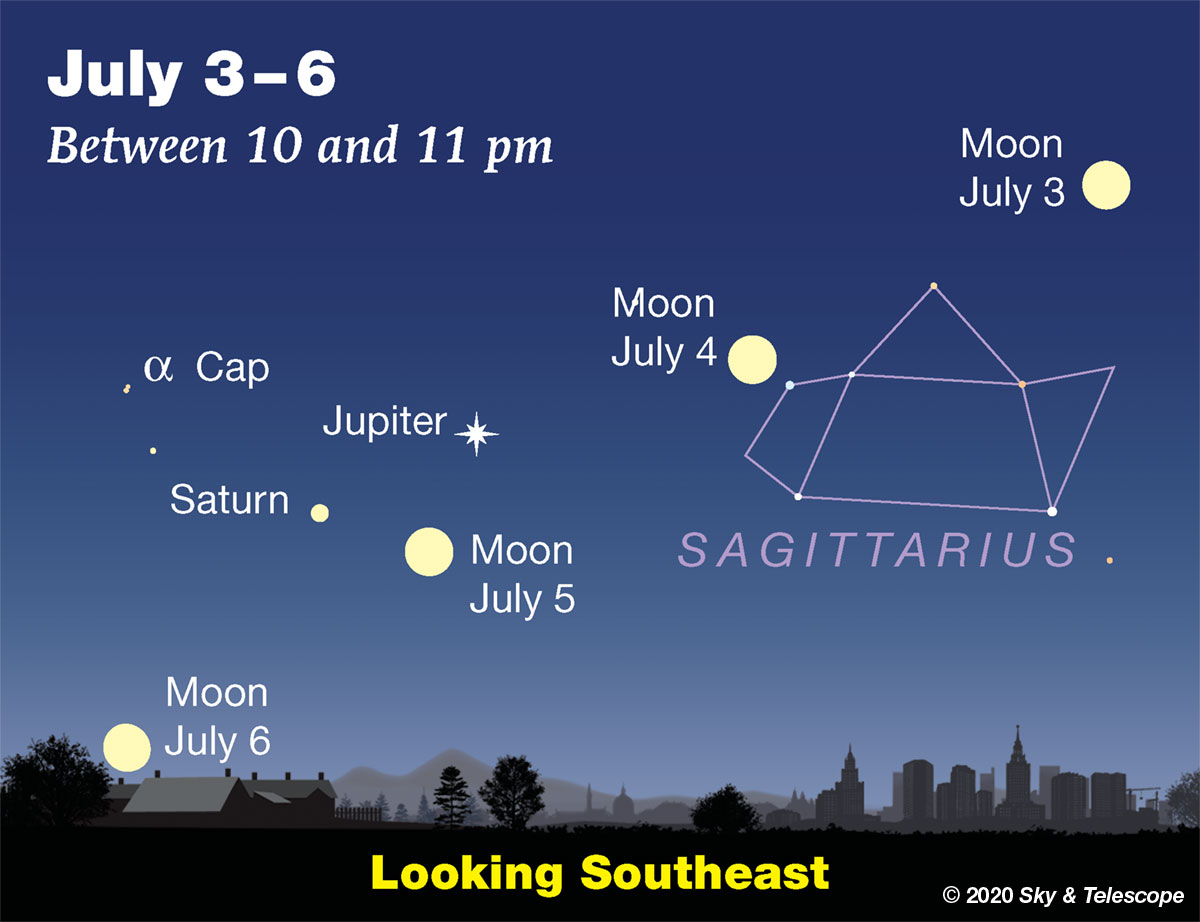
SATURDAY, JULY 4
■ Full Moon (exactly full at 12:44 a.m. tonight EDT). This evening the Moon shines next to the handle of the Sagittarius Teapot, as shown above. How much of the Teapot can you see through the moonlight? It's about the size of your fist at arm's length.
Much easier are bright Jupiter and Saturn, shining to the Moon's lower left.
■ The Moon will undergo a very slight penumbral eclipse tonight for most of the Americas, probably undetectable by eye. The Moon's northern edge will skim through the outermost pale fringe of Earth's shadow, with maximum eclipse coming at 12:31 a.m. Sunday morning EDT; 9:31 p.m. Saturday evening PDT (that's 4:31 July 5 UT). For much of the West Coast, the Moon at that time will be low in the east in evening twilight. Farther east, and for all of Central and South America, the Moon will be higher in a dark sky. Map and details.
At mideclipse the Moon's northern limb will extend only a third of the way across Earth's penumbra. Traditionally, a penumbral eclipse is considered invisible unless the Moon's limb reaches about halfway across the penumbra. Telescopic photos, processed to reveal very weak contrast changes, might succeed in bringing out evidence of this event if your eyes don't.
■ Today Earth is at aphelion, its farthest from the Sun for the year. We're one part in 30 farther from the Sun than at perihelion in January.
This Week's Planet Roundup
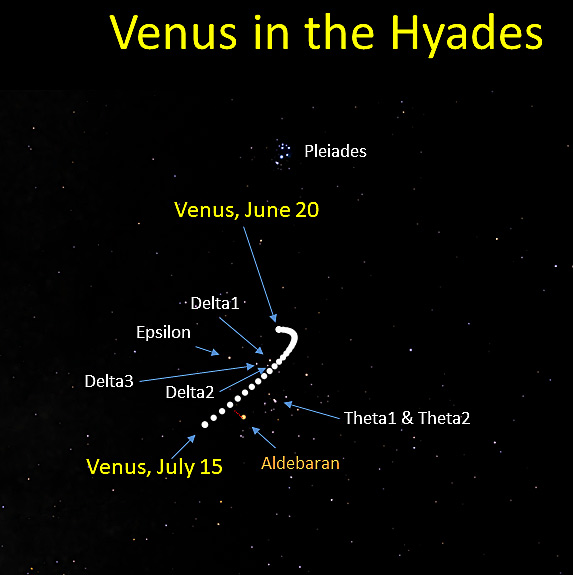
Mercury is hidden in the glare of the Sun.
Venus (magnitude –4.6) shines brightly low in the east in the dawn, as shown at the very top of this page. Look early enough before dawn grows bright, and you may be able to catch the Pleiades about 9° above it. Binoculars help. Look for Aldebaran closer to Venus's lower left. Venus is entering a fine showing as the bright "Morning Star" of summer and fall.
In a telescope Venus is a large, thin crescent, some 45 arcseconds from cusp to cusp and about 15% sunlit. Week by week, it will shrink into the distance while waxing in phase.
Mars rises due east around midnight or 1 a.m. daylight saving time, shining bright orange (magnitude –0.4) in Cetus. Watch for it to come up far below the Great Square of Pegasus and perhaps a bit to the right. By the first light of dawn, Mars shines very high and prominent in the southeast.
In a telescope Mars has grown to 11½ arcseconds in apparent diameter; we're approaching it as Earth speeds along in our faster orbit around the Sun. Mars is as gibbous as it gets, 84% sunlit. Look for the white South Polar cap and for subtler dark surface markings. To see a map of the side of Mars facing you at your date and time, use our Mars Profiler.
Mars will appear twice this diameter when it passes closest by Earth around opposition in the first half of October.
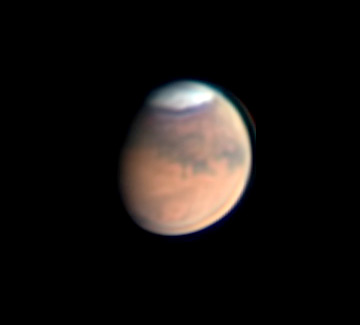
Jupiter and Saturn (magnitudes –2.7, and +0.2, respectively) now rise during late twilight. They hang low in the southeast after dark. Jupiter is the brightest. Saturn is lower left of Jupiter by about 6°.
Farther to Jupiter's right, you'll find the Sagittarius Teapot resting upright.
The two giant planets shine at their highest and telescopic best around 1 or 2 a.m. daylight-saving time, in the south. They're between the constellation figures of Sagittarius and Capricornus. Jupiter will reach opposition on the night of July 13th, Saturn on July 20th.
Keep up with the telescopic interplay of Jupiter's moons and their shadows, and the transit times of Jupiter's Great Red Spot, with the current month's Sky & Telescope, page 50.
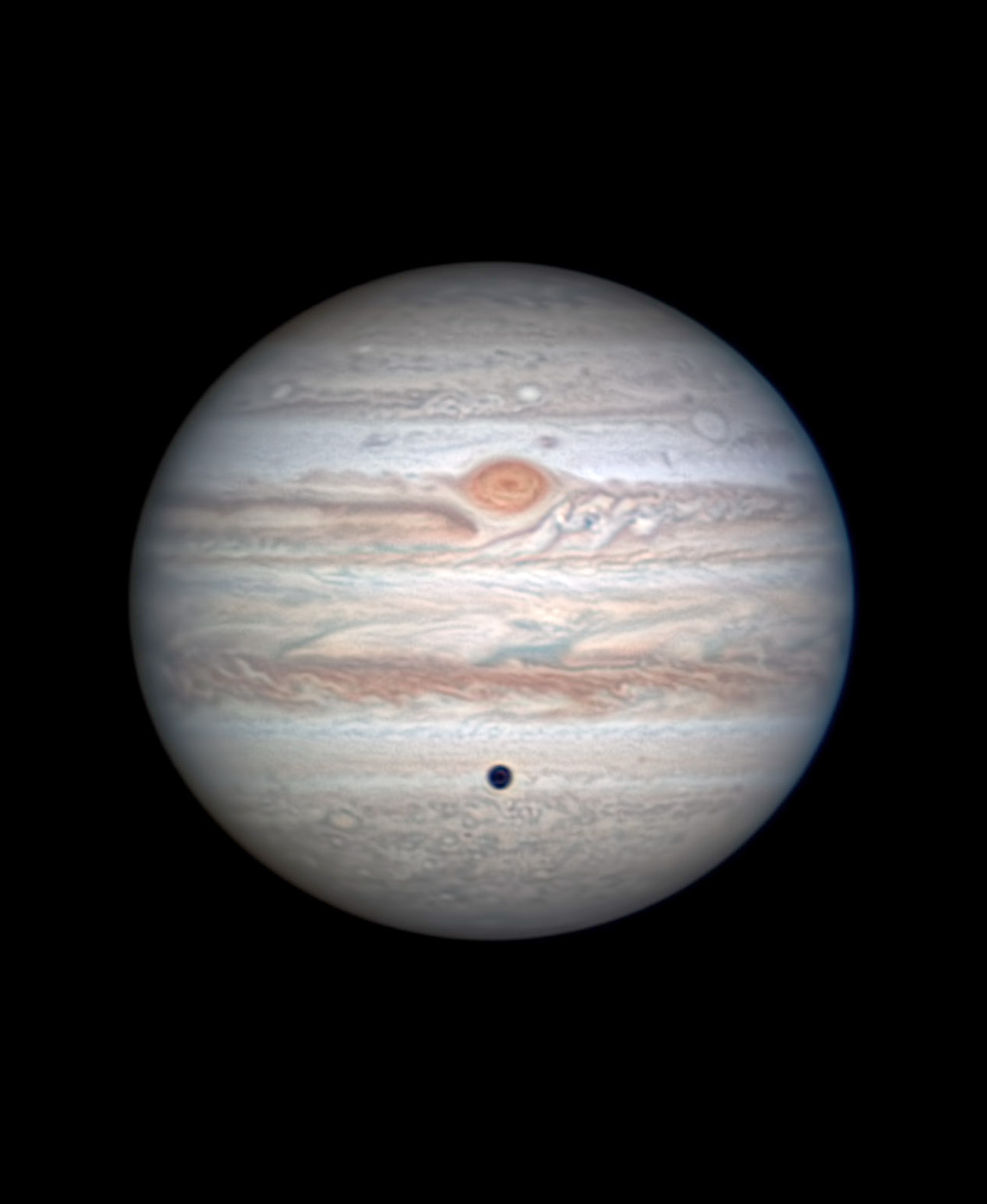
"This image shows a very rare treat," writes Go. "Callisto is in transit with the Great Red Spot. That dark spot is Callisto, not a shadow! I have not imaged a Callisto transit in years." Callisto has the darkest surface of Jupiter's major moons, and that's been enhanced by the boosted contrast here. But even visually, Callisto in transit is easy to mistake for a satellite's shadow.
Go continues, "The Great Red Spot looks very interesting today. ... The wake of the GRS shows very complex turbulence. The 'chimney' north of the GRS [just below it and bending left in this south-up image] is now open. SE [upper right] of the GRS is the area of Clyde's spot. Oval BA can be seen rising." That's the large gray-white spot near the upper-right limb. "Its dark ring is well resolved. The North Equatorial Belt still looks very strange, especially the light NEBn."
Uranus (magnitude 5.8, in Aries) is low in the east before dawn.
Neptune (magnitude 7.9, in Aquarius) is well up in the southeast before dawn, west of Mars.
All descriptions that relate to your horizon — including the words up, down, right, and left — are written for the world's mid-northern latitudes. Descriptions that also depend on longitude (mainly Moon positions) are for North America.
Eastern Daylight Time (EDT) is Universal Time (UT, UTC, GMT, or Z time) minus 4 hours.
Want to become a better astronomer? Learn your way around the constellations. They're the key to locating everything fainter and deeper to hunt with binoculars or a telescope.
This is an outdoor nature hobby. For an easy-to-use constellation guide covering the whole evening sky, use the big monthly map in the center of each issue of Sky & Telescope, the essential magazine of astronomy.
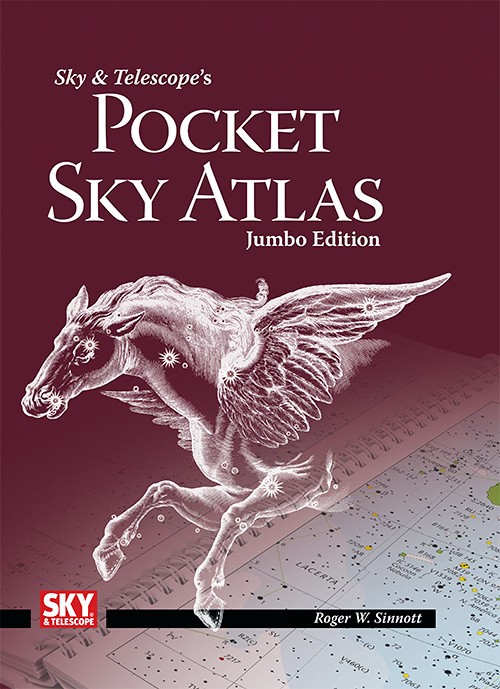
Once you get a telescope, to put it to good use you'll need a detailed, large-scale sky atlas (set of charts). The basic standard is the Pocket Sky Atlas (in either the original or Jumbo Edition), which shows stars to magnitude 7.6.
Next up is the larger and deeper Sky Atlas 2000.0, plotting stars to magnitude 8.5; nearly three times as many. The next up, once you know your way around, are the even larger Interstellarum atlas (stars to magnitude 9.5) or Uranometria 2000.0 (stars to magnitude 9.75). And read how to use sky charts with a telescope.
You'll also want a good deep-sky guidebook, such as Sky Atlas 2000.0 Companion by Strong and Sinnott, or the bigger (and illustrated) Night Sky Observer's Guide by Kepple and Sanner.
Can a computerized telescope replace charts? Not for beginners, I don't think, and not on mounts and tripods that are less than top-quality mechanically, meaning heavy and expensive. And as Terence Dickinson and Alan Dyer say in their Backyard Astronomer's Guide, "A full appreciation of the universe cannot come without developing the skills to find things in the sky and understanding how the sky works. This knowledge comes only by spending time under the stars with star maps in hand."
![]() Audio sky tour. Out under the evening sky with your earbuds in place, listen to Kelly Beatty's monthly podcast tour of the heavens above. It's free.
Audio sky tour. Out under the evening sky with your earbuds in place, listen to Kelly Beatty's monthly podcast tour of the heavens above. It's free.
"The dangers of not thinking clearly are much greater now than ever before. It's not that there's something new in our way of thinking, it's that credulous and confused thinking can be much more lethal in ways it was never before."
— Carl Sagan, 1996
"Facts are stubborn things."
— John Adams, 1770
 6
6








Comments
Rod
June 26, 2020 at 5:04 pm
I see a great image of Jupiter with Callisto transit and GRS shown here. mary beth, I was out this morning shortly after midnight until 0200 or so using my 90-mm refractor telescope. [Some excellent views of Saturn and Jupiter, 71x to 200x and no filters. Light rain over the fields earlier but mostly clear sky when I observed, later altocumulus clouds rolled in and blocked views so I packed up near 0200 EDT. Saturn, rings, Cassini division, and the moons Titan and Rhea very visible. Some cloud banding on Saturn visible too. Various stars were visible in the FOV around Saturn at 71x views. Jupiter was putting on the show now, especially at 200x, so many cloud bands visible. The Galilean moons easy to see too but better at 71x with wider FOV. Saturn and Jupiter are retrograding. Starry Night Pro Plus 8 shows Saturn and Jupiter just less than 6 degrees angular separation.]
You must be logged in to post a comment.
mary beth
June 27, 2020 at 8:09 pm
Very exciting! Nice that we are going to be seeing that beautiful planet scene earlier each evening! Both cloudy and hazy here in Houston. I am my Stellarium+ app to keep up with the Procession. After a week of clouds it always shocks me how much the earth has tilted! When you think about it in seven days is about a 28 minute difference in a position of a star. Hope y’all have some fun plans for Independence Day!
You must be logged in to post a comment.
misha17
June 29, 2020 at 8:44 pm
There is a faint penumbral eclipse visible from the United States on the night of Friday July 4th.
Eclipse begins at 11:07pm ( all times EDT)
Maximum eclipse occurs at 12:29am July 5th, magnitude 0.355
Eclipse ends at 1:52am July 5th
You must be logged in to post a comment.
dlane
June 29, 2020 at 11:51 pm
Your articles are always interesting and informative. This is probably not worth mentioning in this day of not knowing what is right. However, to an old school individual, it's annoying. Wed. July 1, arcturus and Vega are the two COMMONEST types of naked eye stars. Maybe grammar isn't important anymore, sorry.
You must be logged in to post a comment.
mary beth
July 1, 2020 at 12:51 pm
Should they have said ‘most common‘? (I did find commonest in the dictionary) . I am definitely bad about grammar online but usually it is ‘spell wreck‘ changing something I have typed, and my negligence in double checking before I hit send.
You must be logged in to post a comment.
StarGeezer
June 30, 2020 at 10:15 pm
Hey, Alan
Regarding your post about July 2nd:
THURSDAY, JULY 2
■ Look for Antares to the lower right of the bright Moon this evening. The name Antares means anti-Ares, "rival of Mars" in Greek. Because both are fiery orange. Around 1 or 2 a.m. these nights (depending on where you live in your time zone) you can compare them directly. By then Mars and the Moon will be getting low in the southwest, and Mars will have risen to the same height in the east.
I think you mean JUPITER and the Moon will be getting low in the southwest.
Clear skies,
Mark Steven Williams
StarGeezer Astronomy
You must be logged in to post a comment.
You must be logged in to post a comment.